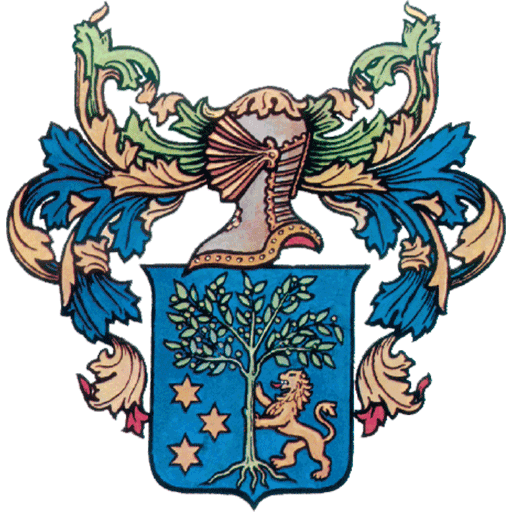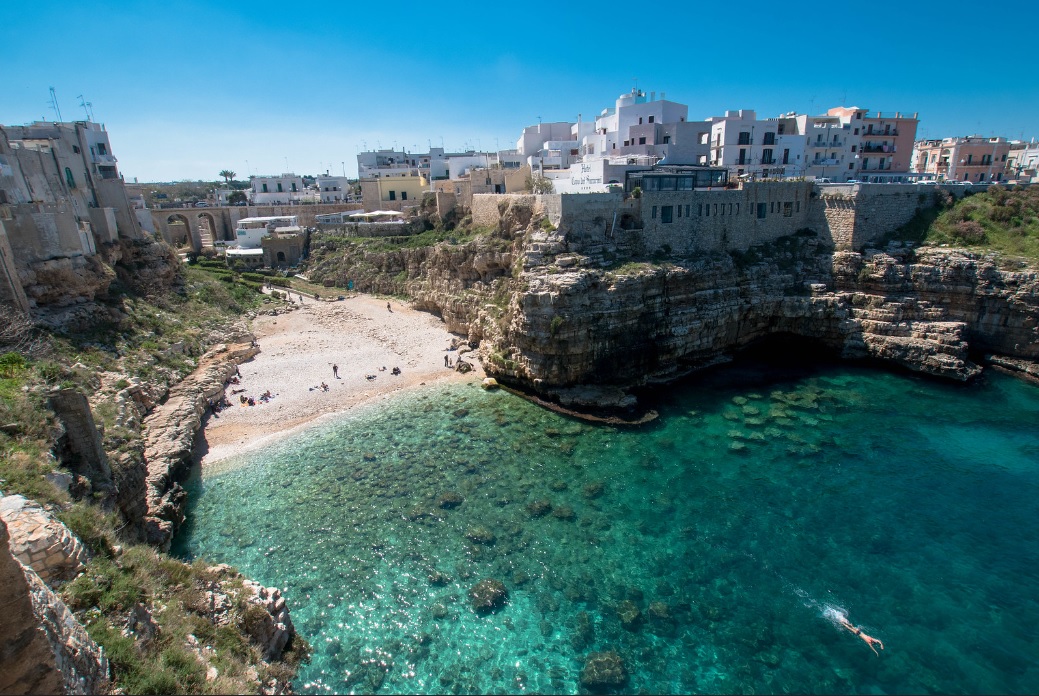
Polignano a Mare
Index
Where is Polignano a Mare located?
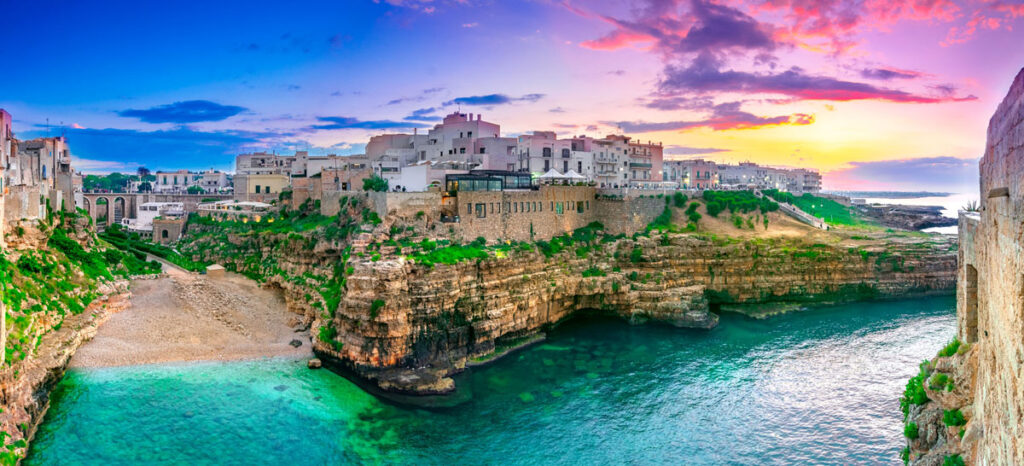
The municipal territory, bordered to the east by the Adriatic Sea, borders to the north with Mola di Bari, to the west with Conversano, to the south-west with Castellana Grotte, in south-east with Monopoli. The municipal territory of Polignano a Mare has two administrative islands (“fractions”) in the municipality of Conversano.
It is characterized by a high and sometimes jagged coast, on which numerous blades have their outlet. One of these, Lama Monachile, is the deep inlet immediately west of the historic center crossed by the bridge, so called because in the past the presence of the monk seal was attested. Another important one is the Lama Santa Caterina. Along the coast there are numerous sea caves including the Grotta delle Rondinelle.
The altitude of the territory ranges from 8 meters in the hamlet of San Vito to 220 meters in the Chiesa Nuova district, on the border with the territory of Monopoli.
Do you want to taste the typical dishes of Polignano a mare cuisine? book your table now!
What to see in Polignano a Mare?
Its marine caves are of considerable naturalistic interest and the historic center and the remains of Roman domination are historically important. Among the latter is the bridge of the Via Traiana, which can still be traveled today, which crosses Lama Monachile, the deep inlet immediately north of the historic center.
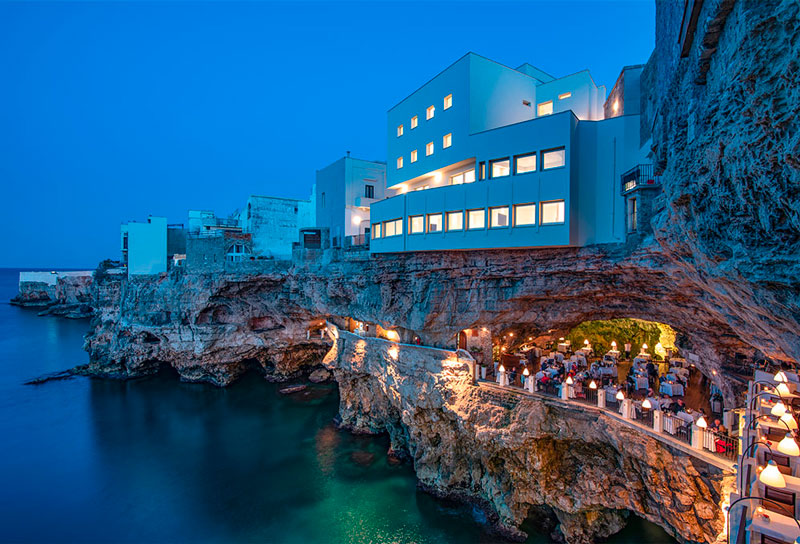
Mother Church of the Assumption
The main church dedicated to Santa Maria Assunta overlooks the small piazza Vittorio Emanuele, the heart of the historic center, it was a cathedral until 1818, when the small diocese of Polignano was aggregated to that of Monopoli. Inside there are some works attributed to the sculptor Stefano da Putignano, active between the sixteenth and seventeenth centuries, and the important polyptych of the Madonna with Child and Saints, of the fifteenth century on a golden table by Bartolomeo Vivarini by ARPAI, as well as a multitude of other small works and precious sacred vestments donated by the former Monastery of San Benedetto, now non-existent. Inside the Church are kept in the Cappellone di San Vito the relics of the saint, a fragment of the arm and the kneecap of the knee.
In the hamlet of San Vito, on the coast to the north of the town, right next to the marina stands the imposing complex of the Benedictine abbey. Furthermore, within the rocky territory of Polignano there are some Masserie: typical buildings dating back to the 17th and 18th centuries, used as farms by large landowners.
Church of Sant’Antonio
Entitled to Sant’Antonio, the church was born at the end of the 16th century in the homonymous square and dedicated to Santa Maria di Costantinopoli. Once it housed the friars’ convent, today there is the First Aid service and the headquarters of the radio station Radio Incontro is also hosted. In the church there are three naves made up of three stone pillars.
Church of San Cosma e Damiano
Built in the late 1800s in a neoclassical style dedicated to the Medici Saints. Inside there are the statues of the Saints Medici, San Rocco, San Sebastiano, Sant’Espedito. There is a large Baroque altar that comes from the ancient Monastery of San Benedetto.
Church of the Purgatory
In the same place where the Church of Purgatory was built in via Mulini there was a chapel dedicated to San Martino, reported in the chapter registers of the fifteenth century, subsequently incorporated into the new building to be used as a sacristy, whose entrance is located to the right of the facade of the new church. Adjacent to the small place of worship was the cemetery of the same name where the youngsters of poor families were buried. On the right side of the chapel it bordered the Hospital of the Annunziata. Given the high rate of infant mortality, the confreres of the Congregation of Purgatory, between 1714 and 1767, had the new church built on the ancient cemetery in the open air and with the offerings of the devotees, which continued to welcome the dead in the tombs. placed inside.
The building, built in Baroque style, has a façade divided into two orders by a high entablature that follows the curved trend of the wall. On the right of the facade rises the bell gable with two arches ending in a rich molded frame. The church is composed of a single nave covered with a barrel vault, interrupted by an elliptical dome, and two side chapels carved into the thickness of the walls, equipped with marble altars: the one on the left consecrated to San Francesco da Paola, the one on the right dedicated to the Immaculate Conception. The main altar, in polychrome marble, consecrated to San Martino, bears on the sides the coat of arms of the ducal Lieto family (1713-1792) who financed the construction of the altar and the organ placed on the choir loft. The church is embellished with five large canvases, one of which, placed on the back wall of the main altar, represents San Michele and the souls in purgatory by the painter Andrea Miglionico. Two other canvases are by Vincenzo Fato: on one the Sacred representation with the Immaculate Virgin and Saints is painted, and on the other the Madonna with Saints Francesco da Paola, Agostino di Ippona and Andrea. The floor is made up of majolica tiles of considerable value laid during the restoration in 1862, characterized by geometric figures and very bright colors.
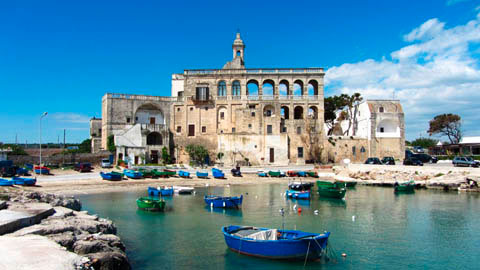
Abbey of San Vito
The Abbey of San Vito, of Benedictine foundation, was designed in the 10th century. From the 16th century the abbey was the home of the minor conventual friars of the SS. Apostoli and in 1785 it became the Regio Demanio. In 1866 the State sold the abbey to the La Greca marquises, who are still fully owned today, while the church is owned by the Fondo di Edifici di Culto of the Ministry of the Interior and is given in concession to the Mother Church of Santa Maria Assunta where on Sundays carries out the mass.
What to eat in Polignano a Mare? Where to eat in Polignano a Mare?

The beauty of a typical Mediterranean historic center and the clarity of marine waters that dig caves and blades among the most evocative in Europe. It is a pleasure to stay in the cool, in the characteristic squares overlooked by the fish restaurants where you can taste the typical dishes of Polignano a Mare.
Raw seafood from Polignano: Italian sushi
Raw seafood does not need any presentation, it is simply a splendor for the eyes and the palate.
Among the typical dishes in Polignano a Mare you cannot escape a beautiful composition of mixed raw food including cuttlefish, sea urchins, red prawns, purple prawns, scampi and many other types of fish dutifully presented as nature made them: raw and fresh.
Some call it Italian sushi, a veritable apotheosis of flavors and textures that color the table.
Carrots from Polignano a Mare
What to eat in Polignano a Mare? You cannot miss the Polignano Carrot, an ecotype of the classic carrot with the particularity of having shades of color from dark plum to canary yellow, a real palette on the plate!
Visit our Bed & Breakfast Polignano a Mare? where to stay in order to visit it.
Its cultivation is carried out in a rather small area, between 10 and 20 hectares, near the city of Polignano a Mare and especially in the hamlet of San Vito. It has obtained the recognition of the Slow Food Presidia, as an example of a new model of agriculture, based on quality, on the recovery of knowledge and traditional production techniques.
The focaccia of Polignano a Mare
Queen of the typical dishes in Polignano a Mare, the Polignano focaccia has nothing to envy to the more renowned Bari focaccia, whose disciplinary is now known thanks to consortia for the protection of this recipe. Soft and tasty, adorned with fresh podorini, here the difference is made by the experience, the oven and the pan!
The fish sandwich in Polignano a Mare
Among the street food not to be missed for a quick but very tasty snack, the sandwiches with fish are the absolute gem.
You can find them walking in the heart of Polignano, where you can buy a fragrant rosette of bread stuffed with seafood specialties such as octopus, raw salmon, prawns and swordfish, often accompanied by local burrata and salad.
The Special Coffee of Polignano a Mare
To close our lunch based on typical dishes in Polignano a Mare you need a nice coffee, but not just any one …
Coffee, sugar, lemon zest, cream and amaretto: these are the 5 magical ingredients that give life to the Polignano a Mare Special Coffee, served in small glass glasses.
What to do in Polignano a Mare?
Polignano a Mare does not offer many alternatives in terms of nightlife and nightlife. The closest nightclub is in fact located in the more populated Monopoli, just 15 minutes by car, while in Polignano a Mare there are mostly lidos on the beach, lounge bars and informal clubs that still offer musical evenings accompanied by a good choice of drink.
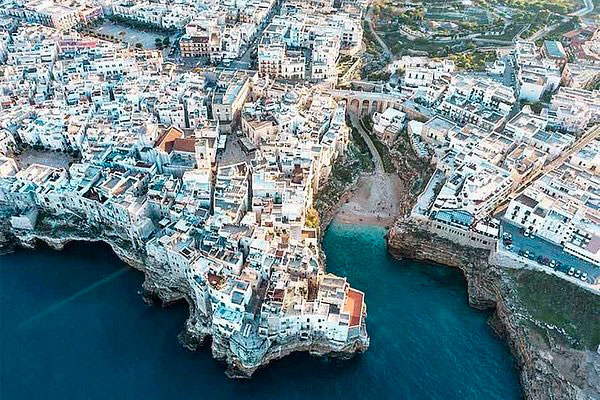
The Scoglio dell’Eremita is a large rock in the middle of the sea, isolated but not far from the coast of Polignano a Mare from which it is only a few meters away. It is located towards the south of the country but you can still see it very close thanks to a pleasant walk along the seafront or, in the summer, a boat ride. The position of the rock has in ancient times given free rein to the creation of tales and legends according to which the rock would be there due to the launch of a giant during a tournament between legendary creatures
The Grotta delle Rondinelle is, among the many caves of Polignano a Mare, one of the best known and largest on the entire northern coast. The cave is accessible to all, as well as from the sea, even from the back in a very easy way. Inside the water and the sand are very clear and you will immediately notice the large suspended vault, about seven meters from the water, and a thin cliff that is held upright as if by a miracle. The cave is very popular especially with photographers, climbers and diving enthusiasts.
The history of Polignano a mare:
The country has a very ancient history. As in the whole area of the south east of Bari, traces of human presence have been found in Polignano, dating back to the Neolithic period, in the hamlet of Santa Barbara.
According to some scholars, the ancient Greek city of Neapolis could be one of the two colonies that, in the 4th century BC, Dionysius II of Syracuse founded on the Adriatic coast. As mentioned, the most evident signs of the presence of man date back to the Neolithic, in the area of Santa Barbara (6th – 5th millennium BC), and in the Manfredi Hypogeum (4th millennium BC), one of the most significant settlements in central Puglia.
Archaeological investigations have revealed the existence of a village dating back to the Bronze Age which, thanks to its position and natural landings, became an important port. In the second millennium BC, the landing of the Iapigi led the villagers to move to the area of the current historic center. The frequentation of these places by Corinthian and Attic merchants is also attested, especially in the Iron Age, when the Land of Bari took on the name of Peucezia. At the beginning of the third century BC, the area of Polignano became an important strategic point for the power of Taranto, with which it had established commercial relations, as evidenced by some pieces of the funerary equipment of a tomb discovered in the area of the bishop’s garden, investigated by the bishop, Monsignor Mattia Santoro, in 1785. The Bishop found a huge, intact sepulcher, containing the remains of an armor, a candelabrum, a bronze helmet and more than 64 vases and ancient objects in addition to the skeleton of the warrior. Sir William Hamilton, English ambassador to Naples visited the tomb calling it “Grand Mausolée”. The best pieces were donated by Bishop Santoro to King Ferdinand IV who placed them in the Royal Museum of Capodimonte of which they constituted “the most precious ornament”. In particular, among the four beautiful large historiated red-figure vases, dating back to the fourth century. B.C. and which exceeded one meter in height, there was one, called the Great Vase of Capodimonte, more beautiful and larger than the others. On it is depicted in the central part an assembly of divinities: Minerva, Apollo, Artemis and Heracles on an Amazon, while on the neck there is a winged Nike on a chariot pulled by four beautiful white horses, preceded by Hecate in the act to raise two torches to lead the way in the darkness. This artifact, one of the most beautiful ever found, is preserved today at the Metropolitan Museum in New York. The path of this Great Vase was reconstructed by the scholar Giuseppe Maiellaro in his book The Divine Assembly – The events of the “Great Vase of Capodimonte” from Polignano to the Metropolitan. The Metropolitan Museum of New York in June 2015 made this research its own by recognizing Polignano as the place where the Gran Vaso di Capodimonte was found.
A thriving center of trade, it was an important statio for the Romans along the road that connected Rome to Brindisi.
Visit our B&B Polignano a Mare? where to stay in order to visit it.

In the 6th century, Polignano was under the jurisdiction of the Byzantine Empire of which the Orthodox religion was adopted. With the advent of the Normans, who dominated until 1194, the prestige of the town grew, thanks also to the work of the Benedictines, present with two monasteries. The Angevin domination made commercial relations with other coastal centers even more dense and many businessmen and merchants, including Venetians, chose Polignano as their home. In the 16th century, following the siege of Monopoli, Polignano also came under Venetian rule for twenty years. Even today in the historic center there is the Doge’s palace, where the Venetian governor resided. In 1530 Polignano was ceded by Venice to Charles V, emperor of Spain. During the Aragonese domination, commercial activities developed under the control of highly skilled Venetian merchants. Defense works were erected for the town, starting from the coast. The town was visited several times by royalty: in 1797, King Ferdinand I of the Two Sicilies, accompanied by his wife and son, stopped there during the journey to Lecce and, after 10 years, King Giuseppe Bonaparte was also received there with big parties.
Abolished feudality, Gioacchino Murat wanted to visit the Kingdom of Naples, including Polignano, to enhance its military capabilities.
Where to sleep in Polignano a Mare?
Choose your home! to sleep near Polignano a Mare in a B&B with swimming pool.
Why visit Polignano a Mare?
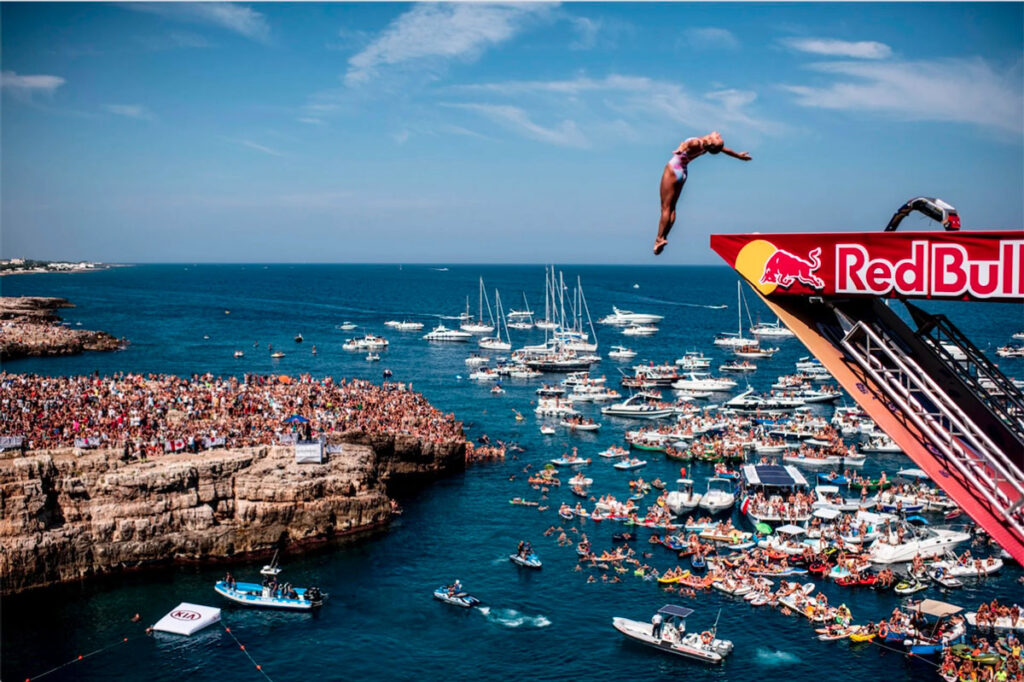
Perched on the rock overlooking the blue of the Adriatic, Polignano a Mare with its beaches, caves carved out of crystal clear water and its white houses is one of the “pearls” of Puglia. Arab, Byzantine, Norman and Spanish traces blend in the narrow streets of its ancient village.
Here was born Domenico Modugno, one of the greatest Italian songwriters, immortalized in a statue on the seafront, where his most famous songs – such as “Volare” or “Nel blu painted di blu” – continue to resonate from the radios of bars and others locals.
The excellent raw materials of which Polignano is rich, fresh fish first of all, but also unique vegetables such as the colored carrots of San Vito, have made its gastronomic offer varied and eclectic, thanks also to contaminations from distant places such as the Japan.
Polignano a Mare is a land of excellence, ancient flavors and traditions and is highly appreciated for its incredible gastronomy and, above all, for the famous carrot which is considered a heritage of biodiversity and taste.

Polignano a Mare is the “pearl of the Adriatic“, a sublime combination of the crystal clear sea and the cliffs of the ancient village that stand out against the blue with a striking and breathtaking overhang. An oasis to discover in the rich province of Bari, where the trulli and caves find their natural outlet to the sea in the village of Domenico Modugno, among the historic alleys, terraces and balconies embellished by the charm of the time.
Awarded with the coveted recognition of the Blue Flag and the 4 sails of Legambiente, Polignano a Mare focuses on the enveloping hospitality of its people, its traditions and folklore to welcome tourists. And in the evening it dresses up with the colors of its cliffs that for millennia have handed down the sounds and charm of the land of Puglia
Do you want to visit Polignano a Mare? and save on the price of the B&B? Check our availability and ask for a discount!
RELATED ARTICLES
Agriturismo Masseria Alberotanza B&B e Ristorante a Conversano
Secondary phone: +393317271337
Email: info@masseriaalberotanza.it

